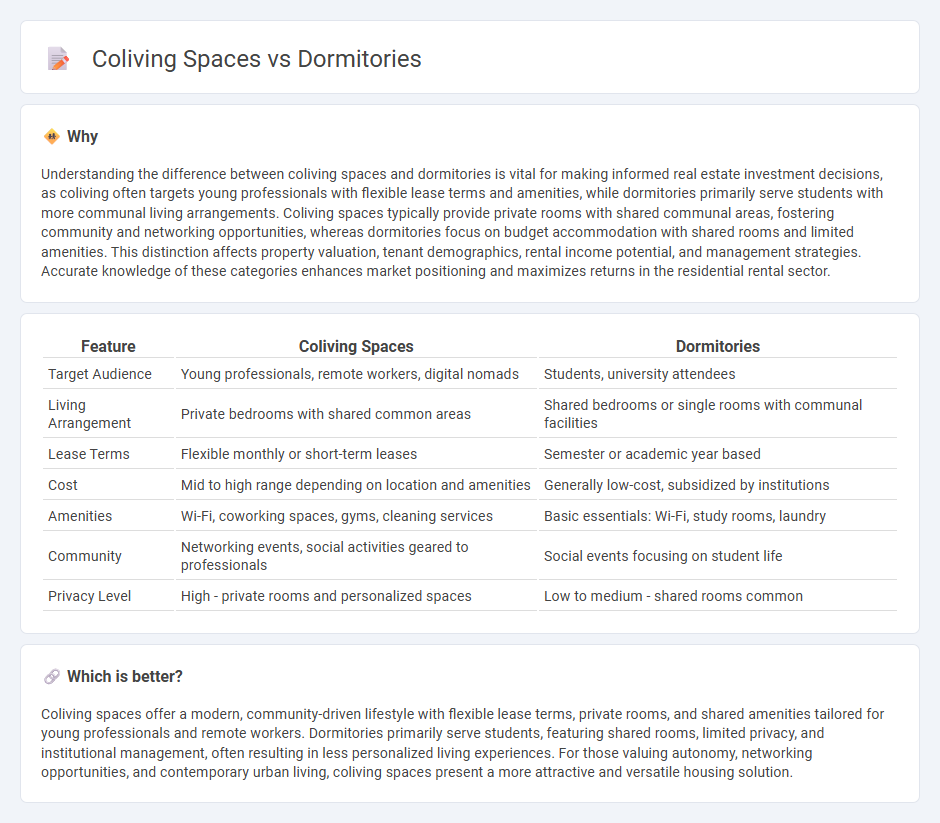
Coliving spaces offer private rooms with shared communal areas, fostering a balance between personal privacy and social interaction, while dormitories typically feature more crowded, uniform living conditions with limited privacy. Real estate trends show a rising demand for coliving options among young professionals seeking flexible leases and a community-oriented environment. Explore how these living arrangements impact urban housing markets and lifestyle choices.
Why it is important
Understanding the difference between coliving spaces and dormitories is vital for making informed real estate investment decisions, as coliving often targets young professionals with flexible lease terms and amenities, while dormitories primarily serve students with more communal living arrangements. Coliving spaces typically provide private rooms with shared communal areas, fostering community and networking opportunities, whereas dormitories focus on budget accommodation with shared rooms and limited amenities. This distinction affects property valuation, tenant demographics, rental income potential, and management strategies. Accurate knowledge of these categories enhances market positioning and maximizes returns in the residential rental sector.
Comparison Table
| Feature | Coliving Spaces | Dormitories |
|---|---|---|
| Target Audience | Young professionals, remote workers, digital nomads | Students, university attendees |
| Living Arrangement | Private bedrooms with shared common areas | Shared bedrooms or single rooms with communal facilities |
| Lease Terms | Flexible monthly or short-term leases | Semester or academic year based |
| Cost | Mid to high range depending on location and amenities | Generally low-cost, subsidized by institutions |
| Amenities | Wi-Fi, coworking spaces, gyms, cleaning services | Basic essentials: Wi-Fi, study rooms, laundry |
| Community | Networking events, social activities geared to professionals | Social events focusing on student life |
| Privacy Level | High - private rooms and personalized spaces | Low to medium - shared rooms common |
Which is better?
Coliving spaces offer a modern, community-driven lifestyle with flexible lease terms, private rooms, and shared amenities tailored for young professionals and remote workers. Dormitories primarily serve students, featuring shared rooms, limited privacy, and institutional management, often resulting in less personalized living experiences. For those valuing autonomy, networking opportunities, and contemporary urban living, coliving spaces present a more attractive and versatile housing solution.
Connection
Coliving spaces and dormitories both serve as shared living environments designed to maximize social interaction and affordability, primarily targeting young professionals and students. These housing models optimize space utilization through communal areas, fostering a sense of community while reducing individual living costs. Their connection lies in combining private and shared amenities to create flexible, cost-effective accommodation solutions in urban real estate markets.
Key Terms
Lease Agreement
Lease agreements for dormitories typically involve standardized, institution-controlled terms with limited flexibility and shorter durations aligned with academic calendars. Coliving spaces offer more customizable lease terms, often including utilities, amenities, and community events bundled into monthly payments with flexible durations. Explore the detailed differences in lease agreements to determine which option best fits your living preferences and lifestyle.
Shared Amenities
Dormitories typically offer basic shared amenities such as communal bathrooms, kitchens, and laundry facilities designed for affordability and practicality. Coliving spaces provide enhanced shared amenities including co-working areas, fitness centers, social lounges, and organized community events to foster collaboration and social interaction. Explore the unique advantages of both living arrangements to find the best fit for your lifestyle and needs.
Occupancy Regulations
Dormitories typically adhere to strict occupancy regulations defined by local housing authorities, limiting the number of residents per room and ensuring basic safety standards. Coliving spaces often offer more flexible occupancy arrangements but must comply with zoning laws and health codes, balancing communal lifestyle benefits with regulatory requirements. Explore the differences in occupancy regulations to understand which option best suits your living needs.
Source and External Links
2025 Best College Dorms in America - Niche - Ranking and reviews of colleges with the best dormitories in the U.S., highlighting features such as safety, amenities, and student satisfaction.
UCI Student Housing | Creating Places to Thrive and Connect - Overview of UC Irvine's on-campus housing options including residence halls, themed houses, and graduate apartments designed to support student success and community.
DORMITORY | English meaning - Cambridge Dictionary - Definition of "dormitory" as a building for living, often near a town or campus, where many people like students or workers reside.
 dowidth.com
dowidth.com